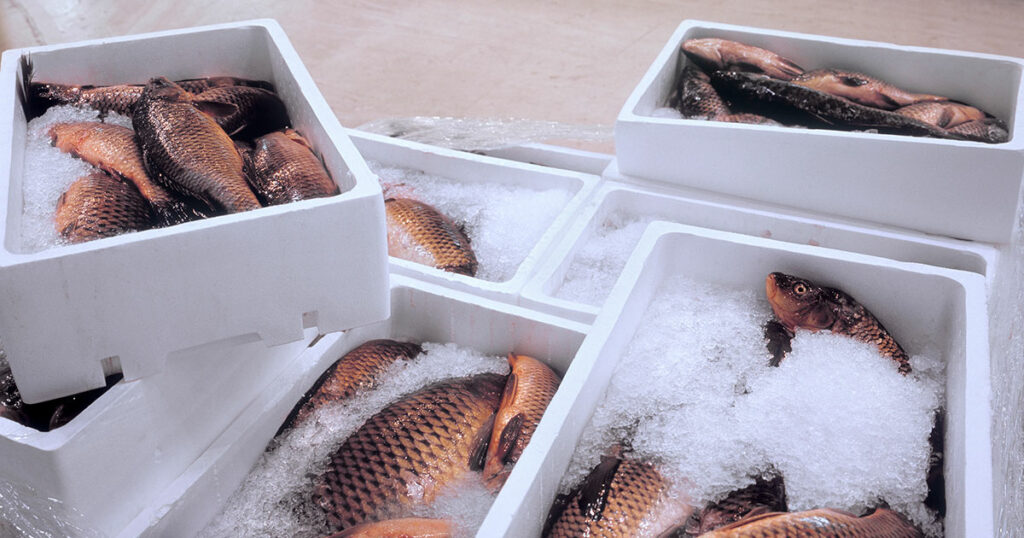Adding fish and shellfish to your diet, whether fresh or frozen, can significantly enhance your culinary experience. To ensure the optimal taste and safety of your seafood, it’s crucial to understand the proper methods for storing fish. Before you embark on your culinary journey, let’s explore some valuable tips for keeping your seafood deliciously fresh, whether it’s in your fridge or freezer.
Selecting Fresh Fish and Shellfish
The foundation of seafood safety begins with making wise choices when purchasing. When you’re shopping for fish, always opt for a reputable source. Look for fish displayed on a bed of ice or within a refrigerator set at a temperature no higher than 40℉. Fresh fish should emit a clean and pleasant aroma, and its eyes should be vibrant and clear. The skin must be firm, while the gills ought to showcase a rich red colour. When fillets are in question, ensure there’s no discolouration around the edges.
If you’re considering frozen seafood, examine the packaging closely. Ensure it’s tightly sealed without any signs of damage. If you can see through the packaging, check for any ice crystals on the fish, which could indicate thawing and refreezing.
For those who catch their fish, act promptly. Store your catch on ice immediately after capture. The optimal method involves using an ice slurry to maintain peak freshness until you return home.
Refrigerating Fresh Fish: Time and Temperature
Once you bring your seafood home, handling it with care is essential. Raw fish and shellfish have a limited shelf life in the refrigerator, typically lasting one to two days before cooking or freezing becomes necessary. Maintain a refrigerator temperature of 40℉ or below to preserve the quality of the fish.
Shellfish with completely closed shells, like oysters, certain clams, and cockles, can be refrigerated for up to seven days if stored correctly. Partially closed shellfish, such as razor clams and geoducks, should be consumed within three to four days.
The duration of fish freezing varies depending on the type of seafood. Commercially prepared frozen fish and seafood and most fresh fish can remain frozen for four to six months if properly wrapped in freezer bags and stored at temperatures below 0℉. However, oily fish like salmon and trout should not be frozen for over three months.
Effective Fish Storage Techniques
Different circumstances call for various fish preservation methods. Depending on your plans for consumption, you can choose from several effective storage approaches.
Refrigerator Storage: If you anticipate using your fish within the next couple of days, retain its original packaging and place it in the coldest section of your refrigerator, such as the freezer or meat drawer. For molluscs and shellfish, rinse them, arrange them on a shallow plate, and cover them with a damp towel or moist paper towels. Avoid sealing these types of fish in a container.

Freezing: When seafood won’t be on the menu immediately, freezing is a reliable option. Individually wrap small whole fish or fillets in plastic wrap before placing them in freezer bags. Don’t exceed 1 pound of fish per bag, allowing for portion control upon thawing. Remember to label the packaging with the date.
For larger fish, freeze them unwrapped until completely solid. Submerge the frozen fish in near-freezing water to create a protective layer of ice. Then, encase the fish in freezer bags or moisture-resistant paper, and label accordingly.

Canning: Utilizing a pressure canner, you can preserve various fish by heating them to at least 240℉. Clean fresh fish promptly, gut them within two hours, and keep them on ice until you’re ready to preserve them. When using glass jars, leave an inch of space at the top before sealing. Home-prepared canned fish should be consumed within one year, while commercially canned options like tuna and sardines can be stored for up to five years.

Essential Fish Storage Tips
Proper handling and storage are vital to prevent cross-contamination and maintain freshness.
When storing raw seafood in the refrigerator, ensure it’s wrapped tightly and kept away from other foods—separate raw and cooked seafood to prevent any potential contamination.
Use hot water and soap to thoroughly wash objects that come into contact with raw fish, such as cutting boards, utensils, and countertops. Always practice proper hand hygiene after handling and storing raw fish.
Detecting Spoilage: Is Your Fish Still Fresh?
Identifying spoiled fish is crucial to avoid foodborne illnesses. Fresh fish should emit a mild, oceanic scent rather than a pungent fishy odour. The flesh should feel firm to the touch, devoid of slim or mushiness. Examine the colour and texture – fresh fish will have a shiny and moist appearance, not a dull, dry, or discoloured one. If you spot mould or other growths, it’s time to discard the fish. Trust your senses; don’t take the risk if something doesn’t seem right.
In Conclusion
Your journey to maintaining fresh and flavorful fish concludes with these invaluable insights. Remember, fresh fish is a culinary delight brimming with nutrition. By following these tips, you’ll be equipped to enjoy your seafood at its finest. Embark on your seafood adventures with confidence, and relish in creating delectable dishes!
Frequently Asked Questions About Fish Storage
1. What’s the best method to thaw frozen fish?
The safest way to thaw frozen fish is in the refrigerator. Transition the fish from the freezer to the fridge, allowing it to thaw slowly. Depending on its size, this process can take up to 24 hours. Avoid thawing fish at room temperature, as it can encourage bacterial growth.
2. How can I determine if the fish is still fresh?
Fresh fish should emanate a gentle, sea-like aroma rather than an overpowering fishy smell. It should possess clear, vibrant eyes and glossy, moist skin. If the flesh feels slimy, it emits a strong odour, or the eyes appear cloudy, the fish has likely passed its prime.
3. Can fish and meat be stored together in the fridge?
While fish and meat can coexist in the fridge, keeping them in separate, sealed containers is imperative to prevent cross-contamination. When storing fish, consider placing it on a bed of ice to uphold its freshness.


Discussion about this post